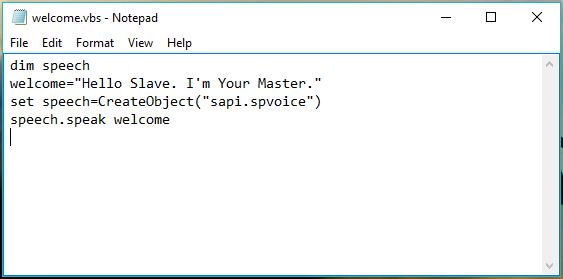The method takes the help of a text file to play the computerized audio recording of any welcome message you would like to hear at Windows startup. You can follow the steps below to add the custom welcome message to Windows 10 or earlier versions.
- First of all, open a new Notepad file. You can do so by typing Notepad in the Start Menu search or finding it in the context menu after a right-click.
- Now, type the following code in the notepad file.dim speechwelcome=”Hello Slave. I’m your master.”set speech=CreateObject(“sapi.spvoice”)speech.speak welcome

Note: You can change the text “Hello Slave. I’m your master.” as per your liking. Make sure the inverted commas are present. - Now, save the notepad file as welcome.vbs. You can use any name, just make sure the file extension is .vbs.You can test the file if it works or not. Just double-click on the file and the sound will start playing. Else, error message will be displayed.
- Now, if you’re using Windows 7, you can type “Startup” in the Start Menu search to locate the startup folder. If you’re using Windows 10/8, press Windows+R to open the RUN dialog box. Now, type shell:startup and press enter.
- Once you’re in the Windows Startup folder, copy the welcome.vbs file you created on the desktop and paste it in the Startup folder.
- All are set. Now, restart your computer to hear the welcome message.
This way you can enable Windows to say anything you want. Just change the text in the VBScript file in the startup folder. After reading this, you might be interested in another Windows article. Read how can turn on desktop flash notifications in Windows 10.
Other vbs script to greeting timing wise.
Step 1:
• First of all copy and paste below Visual Basic Script to Notepad.
• Then save the file as “Greetme.vbs“.[Assign any name you want but don’t forget to add extension “.vbs”] • Now check the saved file is working or not by double clicking it.
• Then save the file as “Greetme.vbs“.[Assign any name you want but don’t forget to add extension “.vbs”] • Now check the saved file is working or not by double clicking it.
Set Sapi = Wscript.CreateObject("SAPI.SpVoice")
dim str
if hour(time) < 12 then
Sapi.speak "Good Morning TechLog" ' Add Your Own Greetings Message.
else
if hour(time) > 12 then
if hour(time) > 16 then
Sapi.speak "Good evening TechLog" ' Add Your Own Greetings Message.
else
Sapi.speak "Good afternoon TechLog" ' Add Your Own Greetings Message.
end if
end if
end if
Sapi.speak "The current time is" ' Add Your Own Time Greetings Message.
if hour(time) > 12 then
Sapi.speak hour(time)-12
else
if hour(time) = 0 then
Sapi.speak "12"
else
Sapi.speak hour(time)
end if
end if
if minute(time) < 10 then
Sapi.speak "o"
if minute(time) < 1 then
Sapi.speak "clock"
else
Sapi.speak minute(time)
end if
else
Sapi.speak minute(time)
end if
if hour(time) > 12 then
Sapi.speak "P.M."
else
if hour(time) = 0 then
if minute(time) = 0 then
Sapi.speak "Midnight"
else
Sapi.speak "A.M."
end if
else
if hour(time) = 12 then
if minute(time) = 0 then
Sapi.speak "Noon"
else
Sapi.speak "P.M."
end if
else
Sapi.speak "A.M."
end if
end if
end if
Step 2:
After successfully completing above step,now we are going to add this Script to our Startup programs.
• So first Enable the option “Show Hidden files,folders and drives” in “Folder Options” setting.
• Then copy and paste script file to:
• Then copy and paste script file to:
“C:\Users\USERNAME\AppData\Roaming\Microsoft\Windows\StartMenu\Programs\Startup“
We are done!
Now onwards your computer will greet you and tell you the current time on startup……. If you face any problem just comment below. Share this simple trick with your friends.
Now onwards your computer will greet you and tell you the current time on startup……. If you face any problem just comment below. Share this simple trick with your friends.

0 comments:
Post a Comment